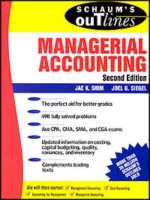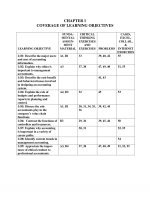Project management accounting, 2e by kevin gary lynne
Bạn đang xem bản rút gọn của tài liệu. Xem và tải ngay bản đầy đủ của tài liệu tại đây (915.96 KB, 226 trang )
FFIRS
04/16/2011
16:27:17
Page 2
FFIRS
05/04/2011
23:41:5
Page 1
Project Management
Accounting
FFIRS
05/04/2011
23:41:5
Page 2
FFIRS
05/04/2011
23:41:5
Page 3
Project Management
Accounting
Budgeting, Tracking,
and Reporting Costs
and Profitability
Second Edition
KEVIN R. CALLAHAN
GARY S. STETZ
LYNNE M. BROOKS
John Wiley & Sons, Inc.
FFIRS
05/04/2011
23:41:5
Page 4
Copyright # 2011 by John Wiley & Sons, Inc. All rights reserved.
Published by John Wiley & Sons, Inc., Hoboken, New Jersey.
Published simultaneously in Canada.
No part of this publication may be reproduced, stored in a retrieval system, or transmitted
in any form or by any means, electronic, mechanical, photocopying, recording, scanning,
or otherwise, except as permitted under Section 107 or 108 of the 1976 United States
Copyright Act, without either the prior written permission of the Publisher, or
authorization through payment of the appropriate per-copy fee to the Copyright
Clearance Center, Inc., 222 Rosewood Drive, Danvers, MA 01923, (978) 750–8400,
fax (978) 646–8600, or on the web at www.copyright.com. Requests to the Publisher for
permission should be addressed to the Permissions Department, John Wiley & Sons, Inc.,
111 River Street, Hoboken, NJ 07030, (201) 748–6011, fax (201) 748–6008, or online at
/>Limit of Liability/Disclaimer of Warranty: While the publisher and author have used their
best efforts in preparing this book, they make no representations or warranties with
respect to the accuracy or completeness of the contents of this book and specifically
disclaim any implied warranties of merchantability or fitness for a particular purpose. No
warranty may be created or extended by sales representatives or written sales materials.
The advice and strategies contained herein may not be suitable for your situation. You
should consult with a professional where appropriate. Neither the publisher nor author
shall be liable for any loss of profit or any other commercial damages, including but not
limited to special, incidental, consequential, or other damages.
For general information on our other products and services or for technical support,
please contact our Customer Care Department within the United States at (800) 762–2974,
outside the United States at (317) 572–3993 or fax (317) 572–4002.
Wiley also publishes its books in a variety of electronic formats. Some content that
appears in print may not be available in electronic books. For more information about
Wiley products, visit our web site at www.wiley.com.
Library of Congress Cataloging-in-Publication Data:
Callahan, Kevin R.
Project management accounting: budgeting, tracking, and reporting costs and
profitability/Kevin Callahan, Gary Stetz, Lynne Brooks.—2nd ed.
p. cm.
Includes index.
ISBN 978–0–470–95234–4 (hardback); ISBN 978–1–118–07821–1 (ebk);
ISBN 978–1–118–07822–8 (ebk); ISBN 978–1–118–07820–4 (ebk)
1. Project management—Accounting. 2. Cost accounting. I. Stetz, Gary S., 1962II. Brooks, Lynne M. III. Title.
HD69.P75C354 2011
657 0.42—dc22
2011002028
Printed in the United States of America
10 9 8 7 6 5 4 3 2 1
FFIRS
05/04/2011
23:41:5
Page 5
To my wife, Angela, and my son, Gary
To Jim, for planting the first seed
To Tracy and Susan, for their love
and generosity of spirit
FFIRS
05/04/2011
23:41:5
Page 6
FTOC
04/16/2011
16:28:52
Page 7
Contents
Preface
xi
Acknowledgments
xv
CHAPTER 1
CHAPTER 2
CHAPTER 3
Project Management and Accounting
1
Mission, Objectives, Strategy
Project Planning
Project Execution and Control
Notes
2
6
11
21
Finance, Strategy, and Strategic
Project Management
23
DuPont Method
Note
24
44
Accounting, Finance, and Project Management
45
Project Team and Financial Success
Calculating Return on Investment
STO Solution Model
Implementing Strategy throughout the Company
Conclusion
Notes
46
53
59
61
68
69
vii
FTOC
04/16/2011
16:28:52
Page 8
Contents
CHAPTER 4
CHAPTER 5
CHAPTER 6
CHAPTER 7
viii
Cost
71
Definition and Purpose of Cost
Cost Classifications
Cost Decisions
Cost of Quality
Cost and Industry
Manufacturing Industry
Conclusion
Note
73
74
80
83
85
89
90
91
Project Financing
93
Debt Financing
Corporate Bonds
Equity
Income Tax Effect
Cost Implications of the Funding Methodology
Conclusion
93
95
97
99
100
112
Project Revenue and Cash Flows
115
Role of the Financial Manager
How to Calculate the Statement of Cash Flows
for a Company
Free Cash Flows
Methods for Calculating a Project’s Viability
Conclusion
Notes
115
119
127
128
137
139
Creating the Project Budget
141
Introduction
Case Study: Pontrelli Recycling, Inc.
Planning for the Future
Creating a Project Budget
141
142
147
157
FTOC
04/16/2011
16:28:52
Page 9
Contents
CHAPTER 8
Review Project Financials
Project Cash Flow
Conclusion
Note
161
162
168
169
Risk Assessment
171
Risk to Your Reputation
Competency
Integrity and Honesty
Organizational Structure
Human Resources
Reports on Financial Statements
Project Specific Risk
Engagement Acceptance
Conclusion
175
176
177
178
179
180
197
199
200
About the Web Site
201
Index
203
ix
FTOC
04/16/2011
16:28:52
Page 10
FPREF
03/28/2011
11:8:58
Page 11
Preface
O
ver the last few decades project management has moved from
its roots in industries such as construction and defense into the
mainstream of American business. Many different industries, in particular the service sector, rely heavily on Project Management as an
integral part of a successful strategy. In support of the widening importance of project management, a number of important professional
organizations, such as the Project Management Institute, have been
created and are thriving in the twenty-first century.
As project management has been recognized as a valid career
path that many have chosen to pursue, many training programs have
been developed, and it is now possible to pursue both undergraduate
and graduate degrees in project management. Project managers who
practice the profession today come from a myriad of backgrounds,
most often having started as specialists in an area of expertise and
gradually moving into project management. And there lies the rub!
In our previous book, The Essentials of Strategic Project Management, we established the primary link between a company’s mission,
objectives, and operations. Senior project managers who wish to remain at the top of their profession need to understand not only the
methodology, tools, and techniques of the profession in order to be
successful, but they must also understand the business context within
which they work. Many, if not most, project managers come from
areas of expertise outside of business, and most do not have the formal education in business, accounting, or finance required to take
their skills to the higher level.
xi
FPREF
03/28/2011
11:8:58
Page 12
Preface
Project management accounting is much more than considering
how project income and expense impact the general ledger. The
topic encompasses traditional accounting, cost accounting, budgeting, financing, cash flow, and earned value along with the more
quantitative subjects. Project management accounting also includes
such areas as strategy and executive decision making, portfolio management, and the more traditional phases of project management.
Project Management Accounting: Budgeting, Tracking, and Reporting Costs and Profitability is meant to improve the business skills of
project managers. The volume contains the basics of project management accounting and finance, including insights into cost accounting,
budgeting, and tracking project profitability. Most important, it
provides project managers with a foundation of knowledge about the
basics of business practices necessary to apply new skills to projects
that they manage.
Chapter 1 is an overview of Project Management as it relates to
a company’s Mission, Objectives, and Strategy. Chapter 1 also points
the reader toward particular topics of accounting and finance as they
relate to project management. Chapters 2 and 3 are two parts of an
introduction to the business basics; the former contains important
foundational knowledge and the latter a case study that illustrates
how to analyze a company’s financial information in order to choose
the right project and understand how to apply proper accounting
principals to a project. Chapters 4 through 6 contain fundamental
information on different areas of accounting and financial expertise,
such as cost accounting and budgeting. Chapter 7 contains a comprehensive case study that illustrates how to develop a project
budget based on a company’s financial performance and needs. The
case study integrates the knowledge, skills, and techniques of
the previous chapters.
The second edition of Project Management Accounting: Budgeting,
Tracking and Reporting Costs and Profitability includes a new chapter
that will increase a project manager’s skills in the area of risk management. The new chapter expands a project manager’s knowledge base
xii
FPREF
03/28/2011
11:8:58
Page 13
Preface
by introducing risk assessment from an accounting and auditing point
of view. Chapter 8 will introduce project managers to a different
professional approach, enhancing their knowledge of the business
environment.
We hope that you will find this book useful in your quest to
become a top-performing project management professional.
KEVIN CALLAHAN
GARY STETZ
LYNNE BROOKS
xiii
FPREF
03/28/2011
11:8:58
Page 14
FLAST
03/28/2011
11:12:19
Page 15
Acknowledgments
T
here are always people to thank when you have taken up an
endeavor such as authoring a book. In particular, we would
like to thank the Faculty and Staff of the Executive MBA program
at Mendoza College of Business at the University of Notre Dame.
There are many individuals there who make that a great program,
but in particular we would like to thank Professors Ken Milani
and John Affleck-Graves, who laid the foundation on which this
effort was built.
We would like to thank Vince Malina, George Beardsley, and
Catherine Callahan for proofreading and correcting our manuscript.
We would also like to correct an error from our previous book,
The Essentials of Strategic Project Management. During the production of that book, we had an excellent intern, Erin Ellis. Unfortunately, Erin was not properly identified, and we wish to correct that
here and thank her for the hard work and professionalism that
she applied to the project.
K. C.
G. S.
L. B.
xv
FLAST
03/28/2011
11:12:19
Page 16
C01
03/28/2011
16:0:54
Page 1
CHAPTER
1
Project Management
and Accounting
I
n today’s business world, we often hear the terms ‘‘strategic alignment’’ and ‘‘mission and objectives.’’ Usually these terms are used
in phrases such as: ‘‘We must ensure that our business units are strategically aligned with our mission and objectives.’’ In many companies,
large and small, it often seems that one area of a company does not
know what is happening in other areas; in some cases, one area may
even be working against other areas within the same company. Quite
often there is a large gap between what the top levels of the organization are saying and what is happening at an operations level within
the company.
In our last book, The Essentials of Strategic Project Management, we spoke about the STO model.1 STO stands for strategic,
tactical, and operational. These three levels of operation inherently
have typical communication problems that many companies need
to deal with (see Exhibit 1.1). Each level of the model represents a
different level of a company. Strategic is the executive level, where
decisions are made about the purpose and direction of the organization. Tactical is the management level of a company, where decisions are made as to how to carry out strategy. Operational is the
lowest level of the company, and represents where people actually
execute the work.
1
C01
03/28/2011
16:0:54
Page 2
Project Management Accounting
EXHIBIT 1.1 Strategic, Tactical, and Operational Model
Mission, Objectives, Strategy
In order to have a clearer understanding of what Mission, Objectives,
and Strategy mean, we need to look at some definitions and examples. Mission, first of all, is a statement of the purpose for the company’s existence. An example of a simple mission statement could
be General Electric’s: ‘‘We bring good things to life.’’ It is simple and
easy to understand. Honeywell’s mission statement is quite eloquent
in its simplicity: ‘‘We are building a world that’s safer and more
secure, more comfortable and energy efficient, more innovative
and productive.’’
In each case, the company’s reason for existence is stated clearly
and simply, giving direction to all that the company does. The reality
is, however, that carrying out that mission is usually much more
complex than a simple statement. Problems arise when management
is not able to turn a mission statement into action and employees do
not understand how their work carries that statement forward. That
situation is where mission is often confused with strategy.
Strategy consists of a series of concrete actions that a company
performs in order to carry out the mission. Each concrete action is
2
C01
03/28/2011
16:0:54
Page 3
Project Management and Accounting
an Objective. The actions must support the mission of the company but must also adhere to good business principles. One of the
fundamental responsibilities of a company is to create a return for
its owners, whether they are a small group of investors or a large
group of stockholders. There is always the responsibility to do this
in an ethical manner, so that carrying out the mission and creating
value are dual fundamental principles of any business. Even a notfor-profit company must create value; without the money, there is
no mission.
An example of a Strategy that might correspond to Honeywell’s
Mission Statement might be to create a new line of home heating
furnaces that are highly efficient and cut down on the amount of heating oil that is used to maintain the home’s temperature. An Objective
for that Strategy would be to carry out research into new technology
for heating oil burners that are more efficient.
Problems arise in many companies when the mission is not understood at all levels, which brings us back to the STO model.
When communication does not exist between the different levels
of a company, mission cannot be translated into strategy and
cannot be carried out by employees. Often the walls between levels
exist, as illustrated in the STO model, not because of purposeful
action or a desire to harm the company, but simply because no one
at the firm has tried to bridge the gap or because someone has tried
and failed.
As mentioned in the preface, senior project managers have their
roots in many different areas of expertise, but the great majority do
not come out of finance or accounting. At the same time, in order to
advance within an organization, project managers need to acquire
knowledge beyond their areas of expertise. The first step toward
advancement is to become proficient in project management knowledge and skills in order to have the flexibility to move beyond those
areas of expertise.
After becoming a proficient project manager, continued experience in project management helps project managers attain senior
3
C01
03/28/2011
16:0:54
Page 4
Project Management Accounting
status. After years of managing larger and more complex projects,
senior project managers often aspire to making greater contributions to their organizations. One way to do this is by gaining expertise in finance and accounting, thereby enabling them to view the
organization from a different perspective and to make a greater
contribution to it.
In this chapter, we review the project management phases from
the perspectives of various project management deliverables and processes with an eye to related finance and accounting issues. This review serves as an introduction to how finance and accounting is
related to project management and can serve to help an organization
perform projects in a manner that supports sound financial and
accounting management. As we review each project management
phase, we discuss the questions for finance and accounting implied
in that phase and indicate which chapter in this book contains pertinent information.
Information Collection
Information collection is a crucial element in project management, finance, and accounting. Collecting the correct information is crucial
for project success. We conduct our review of the project management phases according to the project management documents that
are created during each phase of a project:
&
&
&
4
Initiation: Project charter
Planning: Work breakdown structure, project schedule, project
budget and cash flow, resource plan, procurement plan, quality
plan, risk response plan
If the project is for an external client, there may be a request
for proposal and corresponding proposal and a contract or some
other agreement for services.
Project Execution and Control: Status reports and dashboards.
C01
03/28/2011
16:0:54
Page 5
Project Management and Accounting
In the remainder of this section, we look to each of these documents for information that is important to understanding the financial
health of the project.
Project Initiation
The project charter contains high-level information about the project,
including deliverables, stakeholders, and, in particular, the definition
of success for the project. That definition ought to include a description of the financial success of the project and how it will be
measured. This definition provides the guidelines by which project
performance may be judged.
During initiation, the first questions concerning finance and
accounting are broached. For example, does the project align with
the organization’s strategy, in particular the financial strategy? Does
the project deliver a product or service that is compatible with the
goals and objectives of the organization? Will the project create value
that is within the required return that the organization’s financial strategy and owners or shareholders require? Often project sponsors ask
what a project’s return on investment (ROI) will be. In fact, project
managers can increase their contribution to the organization not only
by understanding a project’s ROI but also by understanding in detail
how that return will be delivered, over what period of time, and at
what cost to the organization.
For example, let’s say that a project will have a 10 percent ROI.
However, if that return is over a 10-year span at 1 percent annually, it
probably would not be considered as valuable as a project that will
return 10 percent annually for 10 years. But even a 10 percent return
over 10 years would not be very interesting if the organization’s cost
of capital is 15 percent. In addition, if the project is considered very
risky, then the organization may require a 20 percent annual return.
Financial levers—ways in which the finances of a company can be
adjusted—are explained in Chapter 2. There are additional illustrations
5
C01
03/28/2011
16:0:54
Page 6
Project Management Accounting
in Chapter 3. The case study in Chapter 7 gives specific examples of
how portfolio management can require criteria based on the financial
strategy of the organization.
Project Planning
Work Breakdown Structure and Project Schedule
The Work Breakdown Structure (WBS) contains a description of each
deliverable that makes up the final project deliverable along with the
tasks that must be performed in order to create each deliverable. Each
task also has a description that defines the inputs, outputs, materials,
and resources required to complete the task. The task description also
defines how long each resource must work to complete the task as
well as how much of each material is required.
The project schedule arranges each task in its proper order of
execution and indicates the order in which the tasks must be done.
The project schedule also defines task dependencies, that is, which
tasks must be completed before other tasks may begin. Based
on these calculations, project managers know when tasks must be
carried out and what the end date for the project is, as well as what its
critical path will be.
Understanding how much work must be performed is crucial to
creating the project budget. During execution, one of the elements
of project control is collecting information about how each task is
executed. If managers do not have an accurate measurement of the
expenditure of resources and materials, then they cannot determine
the actual cost of a project or understand how the project is performing financially.
From the task description, project managers know the amount of
effort that is required to complete the task. They also know when the
task is supposed to be completed. Two basic questions yield information that is needed to get to the true state of the project:
6
C01
03/28/2011
16:0:54
Page 7
Project Management and Accounting
1. How many hours (or days, if the effort is described in those
terms) have the resources been working on the task?
2. How many hours (days) remain to complete the task?
The answers to these questions yield valuable information. By
totaling the two answers, it is easy to find out if the task is taking
more effort than expected and to come up with a prognosis on
whether the task will be completed on time. Multiplying both the
number of hours worked and the hours remaining to be worked by
the hourly rate for each resource reveals not only the cost of the
resources to that task, but also how much additional cost will be
needed to complete the task. Later in this chapter we cover the concept of earned value, which explains how to work with and interpret
this information.
Another concern that project managers monitor by reviewing
effort on tasks and the state of deliverables is ‘‘gold plating.’’ Gold
plating is adding more to a deliverable than is required by the project
specification. It is often a problem on client projects, where resources, with good intentions, seek to add value by doing more
than required. It is also a major source of effort overruns on many
projects. The problem also may be scope creep, where a project
stakeholder has requested that additions be made without getting
proper authorization.
Project Cost
Chapter 4 covers the notion of cost as it affects a project. It is important to understand the difference between cost and expense. The
notion of cost deals with what must be given in exchange for the
value that the project creates. For example, the hourly rate or salary
of resources employed is a cost to the project. The way that resource
cost accumulates will have an effect on the value created. For
example, a contractor charging an hourly rate to a project will affect
cost differently than a salaried employee.
7









